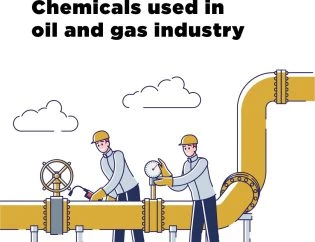
H2S Scavenger Chemical – Introduction
The world has witnessed a substantial increase in E&P of crude oil to meet the need for globalization, leading to drilling of ‘deemed undesirable’ sites, owing to the presence of higher concentration of acidic gases like hydrogen sulphide, carbon dioxide, etc. These hazardous gases require proper measures before disposal or scavenging. Of these, Hydrogen sulphide/ H2S is the most threatening one, especially in confined or ill ventilated places.
The characteristic rotten egg smell makes H2S recognition easy even at lower concentrations. Hydrogen Sulphide is toxic, acidic and extremely corrosive at higher concentrations. Heavier than air, it is found more near base level of the working sites. Then comes its inflammability, which may cause explosive reaction with air molecules. With peroxides, ammonia and other oxidizing chemicals, H2S often goes through combustible reactions, producing hazardous vapours of sulphur dioxide. In humid conditions, it can even form the highly corrosive sulphuric acid.
Less than 20 ppm of H2S concentration may cause eye irritation, throat soreness and burning, dizziness. 80 – 100 ppm may cause serious damage to exposed organs including severe vomiting and breathlessness. More than 500 ppm may cause instant loss of consciousness.
Oilfields involve large metallic installations of drilling rig equipment, on-shore, off-shore rigs, work-over rigs where metallic parts is directly exposed to these drilling conditions, viz., H2S, causing significant damage if unchecked. This gas engages in the electrochemical reaction with metal ions, weakening their key attributes such as strength, stiffness, impact pressure, etc. Hydrogen sulphide acidifies the drilling fluid, catalyzing pitting nature corrosion on pipelines, drilling machinery, etc. The corrosion rate is further accelerated with CO2, also naturally occurring alongside H2S. Together, they have the ability to lower the operational life of upstream and midstream processing units in oil and gas facilities.
The problem with H2S gas cannot be avoided, measures have to be taken to combat and/ or control its effects, with the use of H2S scavenging chemicals. These chemicals on application remove the sulphide gas from the drilling site that comes out with crude, preventing any kind of oxidizing reaction on/ with the metal surface.
How H2S scavenger chemicals work? They form an inert compound on reaction with hydrogen sulphide gas, eliminating even the last traces of hydrogen sulphide from the drilling wells, field condensates and natural gas to improve safety and protection of both equipment and personnel, even meeting the oil and gas specifications. H2S scavengers have been proven to contribute to hassle free performance, with minimal to no impact on further processing at refineries or in wastewater treatment facilities. The cost-effectiveness of the product has gained immense support from the crude unit engineers during gas lift injection and chemical injection and other off-shore production applications. Primary applications of H2S scavengers ensures following results:
- Promptly removes H2S gas
- No effect on crude quality
- Eliminate irritating odor
- Improves operational feasibility
- Reduces corrosion in drilling equipment and pipelines
- Reduces maintenance and replacement costs, supporting asset integrity
- Enhances production performance
Recent Posts
- The Impact of Descaling Chemicals on Industrial Operations: A Detailed Analysis
- How speciality chemicals play an important role in CIP process of Breweries & Microbreweries?
- Propylene glycol has many uses beyond just being an antifreeze. Discover some of them here!
- Chemicals for Boiler Feed Water
- Acid Inhibitor Chemicals for Mineral Acid Corrosion
- Engine Coolant Antifreeze Liquid
- Sulfamic Acid Descalant – How it Works, Where to Get
- Citric Acid Manufacturing Companies in India
- Why You Should Use Morpholine for Your Boilers
- 6 Types of Construction Chemicals to ensure the right cement mix
Categories
- Cleaning & Disinfectant Chemicals (13)
- Energy Chemicals (3)
- Heat Transfer Fluids (3)
- Mostbet (1)
- Performance Chemicals (8)
- Uncategorized (4)
- Water Treatment Chemicals (6)


